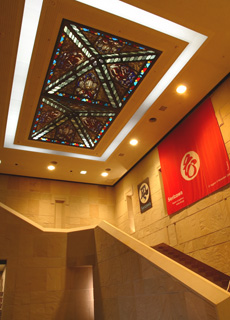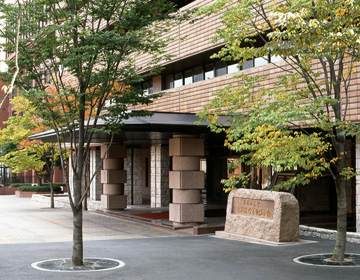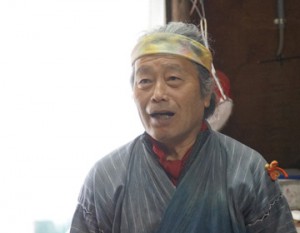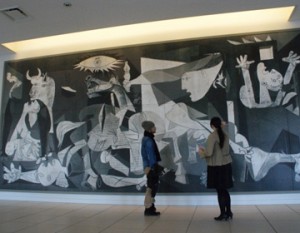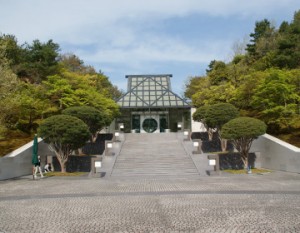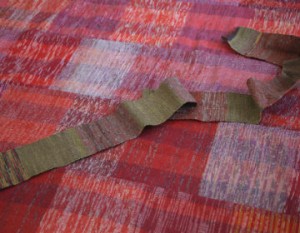Established and expanded “kataezome”
Keisuke Serizawa was born in Shizuoka Prefecture in the 28th year of Meiji (1895), and he graduated from Tokyo Higher Technical School (now Tokyo Institute of Technology), faculty of design. Afterwards, he was greatly influenced by his lifelong teacher Muneyoshi Yanagi, and also by the traditional stencil dyeing of Okinawa called ”bingata”, and he himself started dyeing cloth and paper using paper patterns of tannin paper and dye-resistant -glue made of sticky rice.
His designs are bold and brimming with originality and have symbolic beauty which are projected to his works including kimono, ”noren”, folding screens, calendars, picture books, glass pictures, book covers, and the like.
In 1957, when he was designated a Living National Treasure, the word ”kataezome” was coined to describe the technique he used. He is responsible for establishing and developing ”kataezome”, the art of stencil dyeing.
Serizawa was a master of not only dyeing but many other art forms, and his richness of style was loved by many.
Many of his works can be seen at the Tohoku Fukushi University Serizawa Keisuke Art and Craft Museum, where Nakata visited on his trip to Sendai-shi.
♦Photo on the left: ”Nawa Noren Fuminoren” stencil dyed cotton 1955 from the collection of Tohoku Fukushi University Serizawa Keisuke Art and Craft Museum
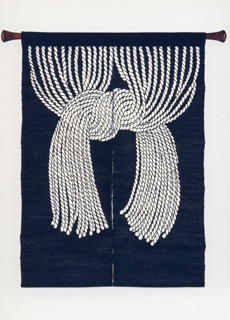
Numerous works and a huge collection
Serizawa Keisuke Art and Craft Museum is situated in the 2nd building of the Kunimi campus of Tohoku Fukushi University, and it consists of six exhibition rooms on the first, 5th and 6th floors.
Within the collection, there are about 3000 pieces by Keisuke Serizawa, and about 10,000 stencils which were essential for his creations. Also, there are valuable collections such as stained glass designs, and hand painted pictures and drawings, which illustrate the artist’s creative process.
Another characteristic of the museum is, that it owns and displays a collection of folk art which Serizawa had collected from around the world. The items collected from China, Southeast Asia, Africa, Central and South America and North America, are given added value through the aesthetic eyes of Serizawa, and are called ”his other creation”.
In order to display the huge collection, the museum changes the exhibits three to four times a year, and displays the pieces according to certain themes.
♦Photo on the right: ”a swimming red snapper Fumi-Kimono” stencil dyed on ”tsumugi”
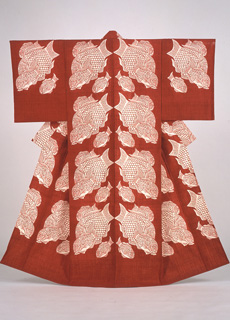
Tohoku and Keisuke Serizawa
Serizawa had a deep relationship with the Tohoku region. He empathized with ”the Japanese Folk Craft Movement” advocated by Yanagi Muneyoshi, became one of its leading members. He was devoted to replace the value of folk craft that existed in the everyday life of the Japanese as well as those items which had not been regarded as artistically valuable. The word ”folk craft” itself was born out of this movement.
He visited potteries in Tohoku, encountered the cultural climate of the snow country, and loved visiting the town of Sendai and Naruko Onsen. And it was his own wish for a museum in Tohoku to display pieces of his work.
The works in the Serizawa Keisuke Art and Craft Museum lauded their beauty quietly, even after several decades. ”They are traditional but modern. They don’t feel old at all though they are from more than fifty years ago.” said Nakata. A museum in a university. We would definitely recommend a visit.
(Photo provided by: Tohoku Fukushi University Serizawa Keisuke Art and Craft Museum)
